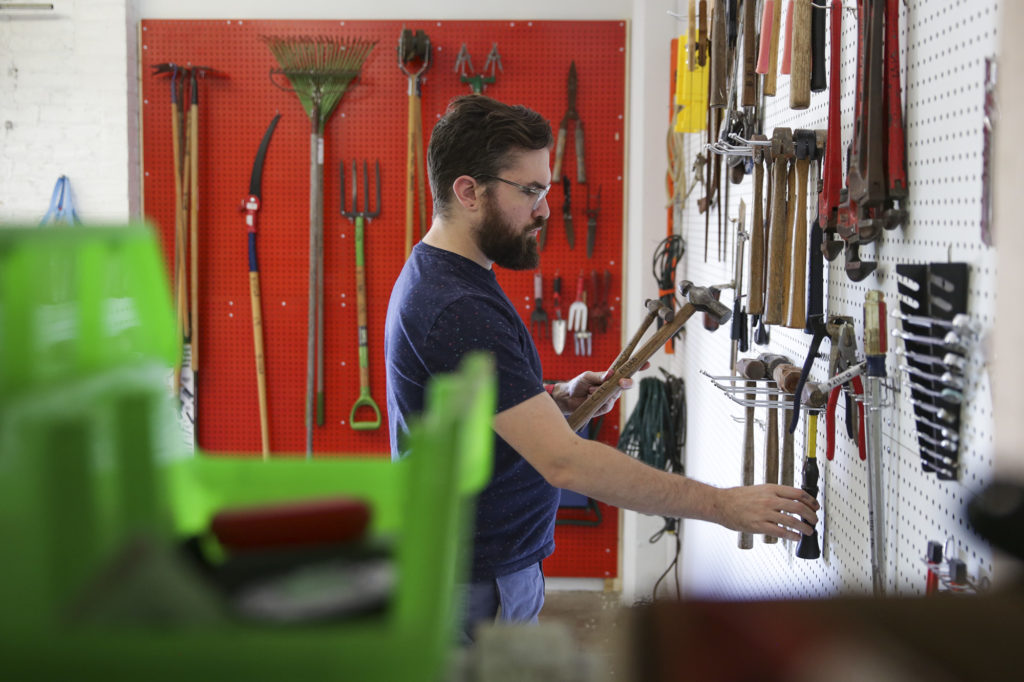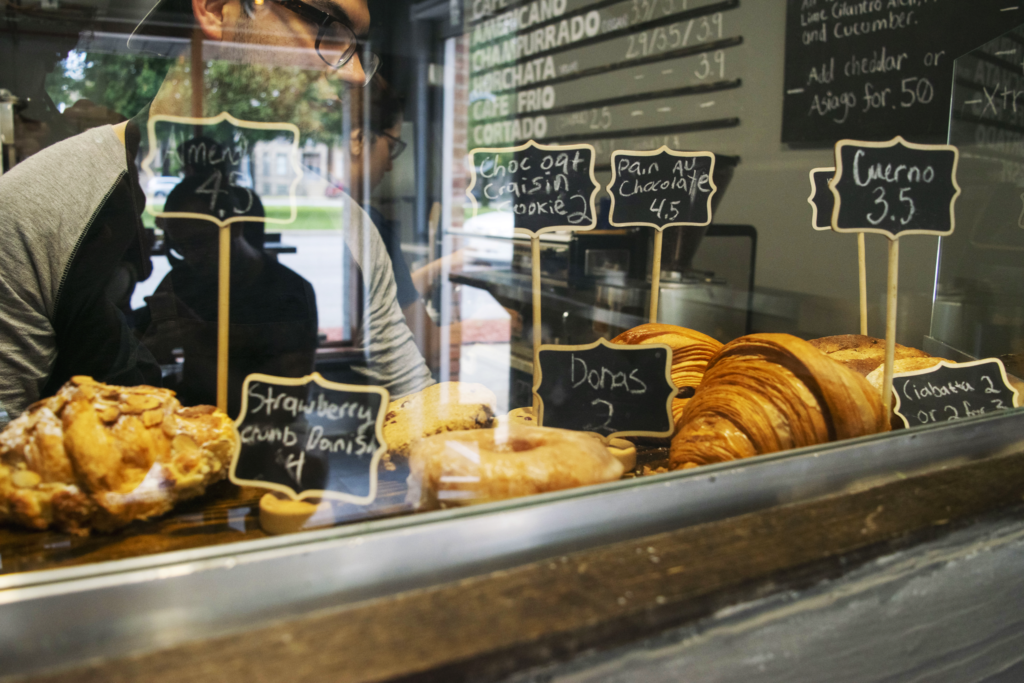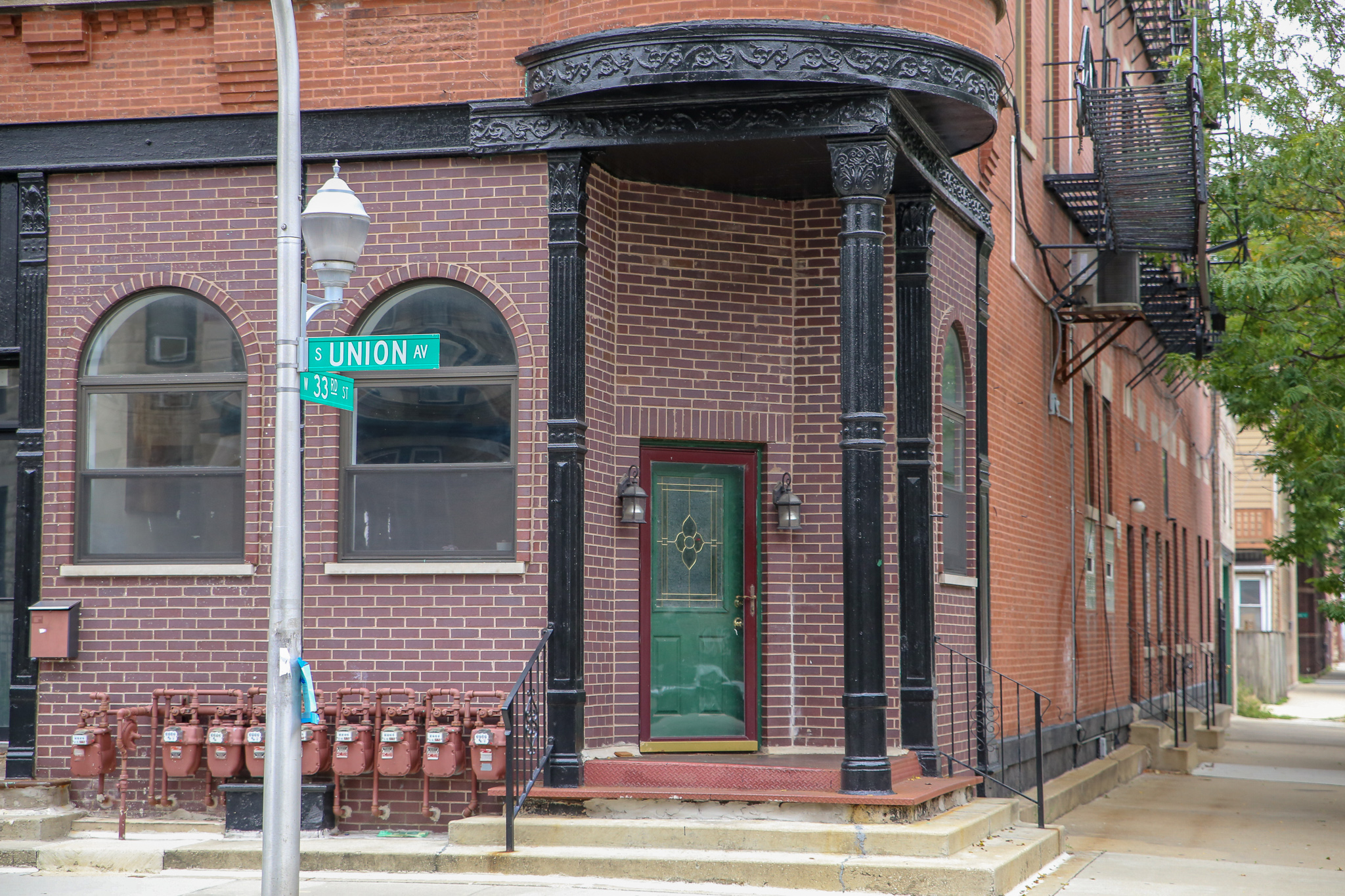- Best New Brunch: Pochos
- Best Corner Doors
- Best Post-Shopping Tamales: Tamale Stand Outside Cermak Fresh Market
- Best Tool Library: The Chicago Tool Library
- Best Window into Baking: Butterdough
- Best Place to Learn Chinese Dance: Yin He Dance
January Overton is a lifelong Bridgeport resident and the owner of Jackalope Coffee & Tea House, which has been in business for seven years, and The Bitten Hand, a gift shop that opened in July in the space adjacent to Jackalope.
I grew up here. It’s definitely changed since I grew up, of course. My mom’s family’s originally from Poland. And they had migrated here. So I’m fifth generation in Bridgeport. Even at [St. Mary’s] church, I was fourth generation to be married at that church. It’s kind of funny since I grew up in this neighborhood, but then I would go to the North Side a lot with my friends and stuff. So I got the mix of the north and the south. But even when we first opened up Jackalope, some old school Bridgeporters were like, “Fuckin’ yuppies opening up their coffee shops,” and I had to come on the [neighborhood social media] pages and be like, “I went to third grade with you. This is January.” But even if it wasn’t me, why are you mad that there’s somebody opening a business in our neighborhood? There’s still some of that mentality. This guy came in here today and said he was at Dunkin’ Donuts the other day and [some customers] were talking and he said to one of them, “Oh, you should go to this good coffee shop, there’s one called Jackalope.” And one of the customers is like, “No, that’s the Satan-worshipping coffee shop.” And I guess one of the workers is like, “Yeah, I’ve heard that too.” He came and he’s like, “Are you aware people think that you guys are, like, Satan-worshipping?” I’m like, “Okay.” It’s so funny how old-school people are set in their ways.
The west side [of Halsted] is more known as artists, or the hipsters moving in over there. And then this side [east of Halsted] people think it’s more like the families who’ve been settled for generations and might be a little more affluent. There’s this perception almost like there’s two Bridgeports. And then over by Duck Inn, people call that The Island, because that’s beyond the viaduct, and there’s water.
My sister’s in Michigan, now my mom’s in Florida. I have some family here, like my aunt lives on 30th and Parnell, she’s lived there for seventy years, and my cousin lives over there. But some of my family has moved on. And I stayed, which is kind of funny. But I feel at home here. I moved out when I was seventeen, and I got my first apartment. It was at 26th and Emerald, right above the fortune cookie factory. A girl came in today and said she moved to 32nd and May. And I knew like three people on that block. People will post pictures on Bridgeport [Facebook pages] and be like, “Oh, here’s me and my buddy hanging out.” And I can literally look at the picture most of time and be like, “That’s Union [Street].” I’ve just been here for so long. But I’ll be honest, before I bought this place, I considered moving up to Portage. I went up there and, I don’t know, it just felt so wrong. I think people think of me as like the Bridgeport ambassador.
I feel like we’re a secret pocket in the city. But you can get on 94, you’ve got the Red Line, you’ve got the Orange Line, you’ve got 55. We’re a central hub to get anywhere in the city. I mean, if you look out this window, that’s how close we are to downtown. See the Sears Tower? It’s nice that some people can come here and they can find cheaper rent, but they can still get downtown, you can still go to school. If you can find roommates, you can get a nicer place. And you can go to the UIC or IIT and you can actually thrive. Up in Logan Square, they’re bragging about $1,500 for a studio. Down here you can get like a two bedroom for like $1000 and still be able to work a job and go to school. You can go to Pilsen, you can go downtown. There’s a lot of things to do nearby.
I love the changes that happen in the neighborhood. I think there was an article recently that said we’re the seventh-most-diverse neighborhood now in the city. And I was like, fuck yeah, that’s awesome. Jackalope is known as one of the most diverse places in the neighborhood, and I love that. Our staff becomes friends with customers really quickly. And it’s like you know these people and then you’ll go Bernice’s [Tavern] and you’re like, “Wait, you work at Jackalope,” and then you go to Maria’s and you’re like, “Wait.” You start figuring it out. It gets like a cruise ship in Bridgeport. You get on a boat, you’re like, “Oh my god, there’s so many people on the boat.” And obviously, you see the same people over again. You’re like, “Oh, it’s actually a lot smaller than I think it is.” (As told to Mari Cohen)
Best New Brunch
Pochos
Although Pochos has only been open for a few weeks, the newest restaurant in McKinley Park is already drawing large crowds. I passed by on a Sunday morning and saw the space packed with smiling patrons. When I returned around noon to try the restaurant’s offerings myself, the place was still full.
After putting my name in and getting seated, I decided on the breakfast pambazo without chorizo and a naranjada (fresh squeezed orange juice and Topo Chico mineral water). The pambazo came on a light and flaky croissant from nearby Butterdough Bakery (also featured in this issue). The sauces were delicious and expertly combined. The potatoes and eggs were beautifully cooked. The dish, which also included a small side of beans, was filling without being overly heavy.
Pochos serves a wide range of dishes, including a mixed-berry french toast, shakshuka, and a chorizo and poblano benedict. The restaurant also offers several fresh juices (orange, grapefruit, and pineapple), which are refreshing in their own right and can also serve as great mixers for drinks that guests bring to the BYOB establishment.
As of now, Pochos is only open weekends and Mondays. However, the restaurant’s owners hope to expand to seven days a week in the near future. Keep your eyes open for more from this great addition to McKinley Park’s food scene. (Joshua Falk)
Pochos, 2025 W. 35th St. Saturday–Monday, 9am–3pm. $10–$15. (773) 475-7829. pochoschicago.com
Best Corner Doors
Two years ago, when I first started looking for an apartment among the two- and three-flats clustered together on Bridgeport’s mostly quiet side streets, I was especially charmed by the neighborhood’s corners. Apartment buildings at the end of the block often have “chamfered” corners, which, in architecture-speak, means that its exterior walls don’t meet at a simple right angle on the corner of the street; instead, the building has a diagonal pane that acts as a “transition” between its two faces. In Bridgeport, these chamfered building corners often host one of the building’s entrances. Sometimes, these diagonal corner doors are accompanied by a triangular corner stoop, often held up by a pole or column. With all the angles and corners and poles, opportunities for pretty designs are endless. The chamfered corners are often a sign that the building was once a retail store, back when small businesses peppered the neighborhood’s residential blocks.
One of the reasons I love living on my block of Union, near 33rd, is that the corners here are especially good: on my side of the street, there’s a large-for-Bridgeport red brick apartment building with the entrance for one unit on the corner: the triangular three-step corner stoop is held up by three grand black poles and the bright green door is set back from the street. (Landlord, if you’re listening, paint the poles and the building’s trim green again! It looked better that way!) Across the street, the corner door has no stoop and instead juts right up against the sidewalk, where you can admire the flowery design in its glass panes. Wander the neighborhood awhile and you’re bound to find some favorite corner doors of your own. (Mari Cohen)
Best Post-Shopping Tamales
Tamale Stand Outside Cermak Fresh Market
Get your grocery shopping out of the way and then reward yourself with one of the most affordable indulgences out there: a $1.25 homemade tamale from the cart right outside Cermak. The tamale options are chicken with green salsa, pork with red salsa, or vegetarian-friendly cheese with peppers. The corn dough is soft and flavorful, while the filling is just right, not too sweet or too spicy. They’re compact but filling: one makes a good snack, while two or three can be a meal. You can also try Oaxacan tamales—larger ones wrapped in a banana leaf—or champurrado, a warm chocolate drink made from corn flour. (Mari Cohen)
Right outside the door to Cermak Fresh Market, 3300 S. Halsted St. Typically open Monday–Sunday from 9am–5pm. $1.25 per tamale. Cash only.
Best Tool Library
The Chicago Tool Library

The Chicago Sustainable Manufacturing Center on 37th Street hosts many businesses that embody a maker ethic, but for those who want to bring the buzz of the contemporary maker to their own home, the newest tenant will surely intrigue. The Chicago Tool Library, which had its soft opening in mid-August, is an initiative that allows you to check-out tools the same way you would books at the Chicago Public Library. It’s a product of the shared effort of many, but the brainchild of co-founder Tessa Vierk.
From the beginning, Vierk believed the idea of a tool library would be to provide access to resources and to cultivate an atmosphere of collective authorship. Back when the library was just a seedling, Tessa released an Internet survey to gauge interest from around the city. One survey flashing in the inbox was Tessa’s eventual collaborator and co-founder, Jim Benton, who was eager to devote more time to making a tool library happen in Chicago. Together the two were able to unfasten a tool box for the public.
As you enter the library through a garage door, you’ll gape over the rows of hammers, jigsaws, and kitchen appliances and cock your head just a little when you discover none of the tools need to be purchased. The donations for this lending library keep flowing as vanloads pass through filled up high, since people see the library as a rewarding way to pass on collections of stuff they no longer use. During my visit I considered what I too could bequeath, but found my thoughts were interrupted as I noticed the newest acquisition, a table saw, being dropped off and carried over to the growing queue of items to be inventoried.
The purpose of the library, as stated on its website, is “to combat inequitable and wasteful consumerism and build community and opportunities for growth.” Observing the glowing cheer of the space, it becomes clear their intention is to produce a reward shared by all who join in. Membership at CTL is based on a self-decided sliding scale—for Vierk, if someone is unable to afford membership at the Tool Library then it is no longer accessible, defeating the purpose entirely. Membership is annual, and the suggested one dollar for every $1,000 of annual income feels consistent with their statement of purpose. The Chicago Tool Library is a conduit for possibilities. When you visit, you’ll not only marvel at the ease in which this project has seemingly come together but also, infected by cooperative joy, you’ll likely sign your name on the dotted line. (Leo Williams)
Chicago Tool Library, 1048 W. 37th St., ste. 102. Saturday & Sunday, 10am–3pm. chicagotoollibrary.org
Best Window into Baking
Butterdough

Walking into the newest bakery in McKinley Park, on Western Avenue, you realize this spot is close to almost everything you need: parks, schools, the “L,” gyms, and major bus stops. The shop itself is inviting and enchantingly bright, with a windowed front and thoughtful décor: small cacti, little wooden tables and stools, and an entire chalkboard wall covered with whimsical art and quotes. You enter the space and find yourself directly in front of the counter, which offers a clear view of the raw dough waiting to be cooked, as well as all the baking equipment.
As I stood at the metal counter, Butterdough’s bakers—brothers and McKinley Park residents Lalo and Uva Leon—kindly answered my questions and walked me through their daily processes. I was fortunate to only have cash to limit my impulsive purchases after considering almost all of the options, which included blueberry crumble Danish, conchas, and vegan horchata.
I didn’t have the opportunity to eat any of their tempting sandwiches, but I bought three pastries and a latte to take home to mi mama, who was recovering from illness. Local pastries, unavailable anywhere in my neighborhood, seemed like the treat to sweeten her difficult week. These goodies were packaged in a light cardboard box, stamped with Butterdough’s logo of a small deer (a doe) and a fading moon, to make sure the pastries didn’t collapse on my walk back home.
Once I arrived home, I opened up the box with a plain croissant, an almond croissant, and a strawberry Danish waiting for us to dig in.
The strawberry Danish immediately caught our eyes. Dozens of layers were held together with the strawberry jam, and a soft crumble of brown sugar danced off to its edges when we sliced it. Mi mama commented in Spanish: “This [Danish] is a fine bread that I would eat again. No fake sweetness. Tons of sugar makes me not eat bread, but this one is good.” For me, every bite made me slow down and sip the latte to clear my taste buds for another bite.
The almond croissant was next. We cut down the middle through many layers to find a pocket of “almond joy,” as my mom described it. Mi mama said she’d “never had a bread made from almond like this before.” This was a croissant that landed the balance between flakiness and creamy texture in every bite—until you realize you’ve run out. Mi mama and I laughed when the almond croissant was gone before our almond cravings finished.
The original croissant remained in our box and marked a perfect ending for a journey through sweetness at Butterdough. We discussed possibilities to transform it into various types of savory and sweet recipes. This pastry became a medium for endless directions of flavors for planned breakfast sandwiches.
These homemade goods also brought a moment of respect for the past lives in our memories. Mi mama looked at me and told me that su papa (her dad) was sharing these pastries with us in his spirit. “I thought about him within the bites. He would sing for these pastries.” We smiled and shared eye contact to honor him.
I never knew this about mi tito (my grandfather) until now. I will return to purchase these breads for my ofrenda (shrine for offerings) for Día de Los Muertos. (Jocelyn Vega)
Butterdough, 3452 S. Western Ave. Tuesday–Friday, 5am–3pm; Saturday–Sunday, 7am–4pm. (773) 475-6452.
Best Place to Learn Chinese Dance
Yin He Dance

Yin He translates to “silver river,” which is the Chinese name for the Milky Way and the namesake of Yin He Dance, a nonprofit whose mission it is to bring Chinese dance to a wider audience in Chicago. Founded in 2015, the organization consists of a dance studio offering classes across a range of dance styles as well as a professional dance company that performs across Chicago.
Its studio is located on 31st Street, with a sparsely furnished storefront and an interior dance area with floor to ceiling mirrors running the length of the room. The space is used for dance classes, which are held mostly on weekends at the rate of $120 for a ten-week adult class, and doubles as a practice space for the professional company. “Our goal is to make Chinese dance more accessible for everybody, and create a sort of community within Chinatown for dance,” said Angela Tam, founder and artistic director for Yin He. In addition to a more traditional style of Chinese dance, classes are offered for K-pop, hip hop, and ballet styles. The group puts on a few annual shows, including performances for the Moon Festival and Chinese New Year.
The group’s name evokes the kind of ethereal dance style often associated with what is called Chinese traditional dance, whose range of styles extends well beyond the more widely known dragon and lion dances. Last weekend at their latest show, Visions, the group showcased a collection of traditional and contemporary Chinese dances, some of which were choreographed by Yin He members, followed by a Q&A session that delved deeply into the history of Chinese dance and the meaning behind many of the night’s dances.
The performance was bookended by two ensemble pieces: the first a pensive six-dancer interpretation of the path to attaining Buddhahood, and the last a fun and spirited dance with colorful fans and a team of twelve dancers. In between there were many memorable pieces, including a solo exploring Chinese decorative knots and one titled “Two-Headed Buddha”, a lovely and resourceful two-person twist on the famous “Buddha with a Thousand Hands” dance. But best of all was a contemporary set choreographed by dancer Irene Hsiao. The longest dance by far, it evoked the feelings of grief accompanied by loss, making powerful use of lighting to signal the passing of time and setting it all to the song of a single cello dragging its bow heavily across its body. The dance was in turns sad, creepy, and beautiful—an exciting glimpse of the new possibilities that exist within this traditional dance style. (Tammy Xu)
Yin He Dance, 547 W. 31st St. (312) 869-2572. yinhedance.org


